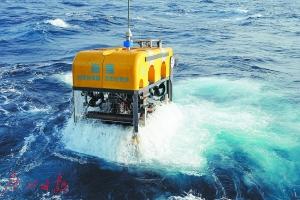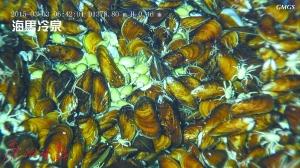Cold seeps in the hippocampus findings or in the South China Sea "combustible ice" Bonanza

"Seahorse" is by far China's largest system, depth most deepest and highest localization rate of 4500 metres unmanned remote-controlled submersibles.

"Seahorse" was captured March 2015 "hippocampus seep" group photo.
"Hippocampus" found Seabed "cold spring"Since 1999, China geological survey Bureau in the northern slope of the South China Sea systems deployed to carry out geological, geophysical survey and research work, outlining a number of potential undersea "cold spring" area.
In March 2015, the preferred conducting confirmatory survey in Western waters of the Pearl River mouth basin, China's independently developed the "hippocampus" 4500 m non-manned, remotely operated vehicles, and found the huge activity of the sea for the first time "cool springs". Because this is the "hippocampus", developed the first application to marine geological survey, so the "cold spring" named "cold seeps in the hippocampus."
The Guangzhou daily news (reporter Huang Dantong correspondent strictures at first photography) Ministry of land and resources, China geological survey Bureau in Guangzhou for the first time to the media yesterday morning "hippocampus cold spring" of scientific findings. Scientists announced that through the investigation, now Guangzhou marine geological survey Bureau, Ministry of land and resources fundamental to identify the "cold seeps in the hippocampus," distribution, topography, biomes, and fluid flow characteristics of authigenic carbonate rocks, etc. According to reports, the "cold spring" places, means that undersea methane gas rose show "cold spring" may exist in the seafloor sediments below gas-hydrate. Scientists first published "cold seeps in the hippocampus," latest results show China exploring "combustible ice" have taken an important step.
Two surveys "hippocampus cold spring"
Yesterday, the "geological survey of China engineering technology center of natural gas hydrate" officially in Guangzhou. It is revealed that the core mandate of the Centre is to build a natural gas hydrate exploration and development of science and technology innovation platform to accelerate resource exploration and development of gas hydrate in China seas, making China lead from parallel to the work.
May 2015 and in October, the Guangzhou marine geological survey Bureau, Ministry of land and resources, "oceanic fourth" survey ship twice her "cold seeps in the hippocampus" area, access to the natural gas hydrate samples. March 2016 through the "cold seeps in the hippocampus," further investigation of the basic "hippocampus seep" range, topography, biomes, and fluid flow characteristics of authigenic carbonate rocks, etc.
"Cold seeps in the hippocampus," Discovery's significance
"Hippocampal cold spring" was found off the Western continental slope of the South China Sea for the first time the scale of activity of cold spring, this find is gas hydrate exploration major breakthroughs. In the "cold seeps in the hippocampus" bottom surface Gets a lot of natural gas hydrate samples, is the Fox God in the continental slope of South China Sea waters and the Eastern Pearl River mouth basin after, major breakthroughs in prospecting in new waters. While, further confirmed has China jurisdiction waters gas hydrate distribution widely, and resources potential huge, for international frontier science problem research provides has important window; "hippocampus cold spring" for research Pearl River mouth basin West waters Harbour gas hydrate decomposition and environment effect, and cold spring biological life origin and evolution, important science problem provides has important according to and experiment platform, will led and promoted China waters cold spring geological and ecological environment research of further in-depth.
"Hippocampal cold spring" found thanks to the "hippocampus" successfully applied. "Seahorse" is by far China's largest system, depth most deepest and highest localization rate of 4500 metres unmanned remote-controlled submersibles, signifies that China has mastered a ROV deep-sea exploration of key technologies, and realizing the rapid transformation of scientific and technological achievements in the investigation.
"Hippocampal cold spring" has three main features
Investigation found that "hippocampus cold spring" is located in the western part of the Pearl River mouth basin waters, overall was like distribution of banded, depth of 1350~1430 metres, an area of approximately 618 square kilometers, which has found the cold spring activity of about 350 square kilometers.
"Hippocampal cold spring" has three characteristics: one is the surface is rich in natural gas hydrates. Gravity bar sampler access to natural gas hydrate samples, depth is only several metres below sea, the shallow depth of just 0.15 m; the second is large outcrops of authigenic carbonate rocks. In the "cold seeps in the hippocampus" seabed exposed a large number of different morphological characteristics of authigenic carbonate rocks, mainly tuberculosis, crust-like and layered, part due to more intense leakage of methane gas, carbonate cemented a number of mussel shells; the third is widely developed cold spring biota. Tube worms, clams and mussels, a variety of cold spring biological coexistence, in which mussels are the most widespread, different types and different growing bio-interactive distribution in space.
(Editors: Pan Yi burn UN657)
2016-06-26 07:03:32
The Guangzhou daily
海马冷泉调查结果:南海或存“可燃冰”富矿

“海马”号是迄今为止中国系统规模最大、下潜深度最深、国产化率最高的4500米级非载人遥控潜水器。

“海马”号2015年3月拍摄到的“海马冷泉”生物群照片。
“海马”发现海底“冷泉” 自1999年起,中国地质调查局在南海北部陆坡系统部署开展了地质、地球物理调查和研究工作,圈定了多处潜在海底“冷泉”区。
2015年3月,优选珠江口盆地西部海域进行了验证性调查,使用中国自主研制的“海马”号4500米级非载人遥控潜水器,首次发现了海底巨型活动性“冷泉”。因为这是“海马”号研发成功后第一次应用于海洋地质调查,故将该“冷泉”命名为“海马冷泉”。
广州日报讯 (记者黄丹彤 通讯员陈惠玲 摄影报道) 国土资源部中国地质调查局昨天上午在广州首次向媒体发布“海马冷泉”的科学考察成果。科学家宣布,通过调查,目前国土资源部广州海洋地质调查局基本查明了“海马冷泉”的分布范围、地形地貌、生物群落、自生碳酸盐岩及流体活动特征等。据介绍,有“冷泉”的地方,就说明海底有甲烷气体升上来,昭示“冷泉”下面的海底沉积物里可能存在天然气水合物。科学家首次公布“海马冷泉”最新成果展示,中国发掘“可燃冰”已经迈出重要一步。
先后两次调查“海马冷泉”
昨日,“中国地质调查局天然气水合物工程技术中心”在广州正式挂牌。据透露,该中心的核心任务是打造天然气水合物勘查开发科技创新平台,加快推进中国海域天然气水合物资源勘查和开发工作,使中国在该项工作实现由并行转为领跑。
2015年5月和10月,国土资源部广州海洋地质调查局“海洋四号”调查船先后两次开赴“海马冷泉”区,获得了天然气水合物可视实物样品。2016年3月,通过对“海马冷泉”的进一步调查,基本查明了“海马冷泉”的分布范围、地形地貌、生物群落、自生碳酸盐岩及流体活动特征等。
“海马冷泉”发现的意义
“海马冷泉”是中国首次在南海北部陆坡西部海域发现的规模空前的活动性冷泉,这项发现是天然气水合物勘查重大突破。在“海马冷泉”区海底浅表层获取大量的天然气水合物样品,是继南海北部陆坡神狐海域和珠江口盆地东部海域之后,在新海域找矿的重大突破。同时,进一步证实了中国管辖海域天然气水合物分布广泛、资源潜力巨大,为国际前沿科学问题研究提供了重要窗口;“海马冷泉”为研究珠江口盆地西部海域海底天然气水合物分解及其环境效应、冷泉生物生命起源与演化等重要科学问题提供了重要依据和实验平台,将引领和推动我国海域冷泉地质与生态环境研究的进一步深入。
“海马冷泉”的发现得益于“海马”号的成功应用。“海马”号是迄今为止中国系统规模最大、下潜深度最深、国产化率最高的4500米级非载人遥控潜水器,标志着中国已掌握了ROV深海探测关键技术,并实现了科技成果迅速转化形成调查能力。
“海马冷泉”具有三大特点
调查发现,“海马冷泉”位于珠江口盆地西部海域,总体呈东西向条带状展布,水深为1350~1430米,面积约为618平方千米,其中已探查发现有冷泉活动的区域约350平方千米。
“海马冷泉”具有三大特点:一是浅表层富含天然气水合物。通过重力柱状取样器获得的天然气水合物实物样品,埋藏深度一般仅海底以下数米,最浅的埋藏深度仅0.15米;二是自生碳酸盐岩大量出露。在“海马冷泉”海底出露大量不同形貌特征的自生碳酸盐岩,主要呈结核状、结壳状和层状,部分区域因较强烈的甲烷气体渗漏,碳酸盐岩胶结了大量贻贝壳体;三是冷泉生物群广泛发育。管状蠕虫、蛤类及贻贝等多种冷泉生物共存,其中贻贝分布最为广泛,不同种类和不同生长期生物在空间上交互分布。
(责任编辑:潘奕燃 UN657)
2016-06-26 07:03:32
广州日报